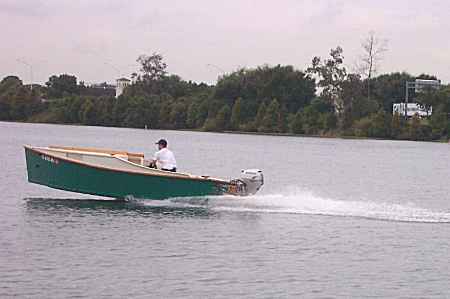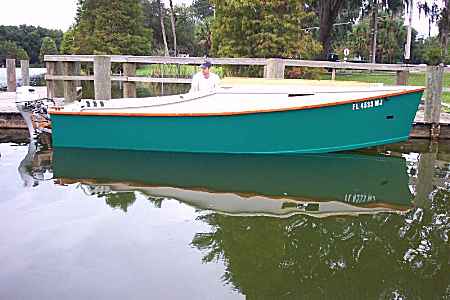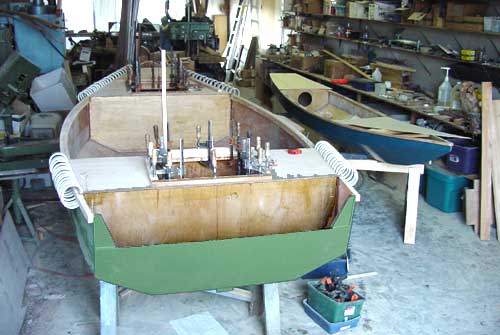
Bayard Cook warms up his delux AF4.
Contents:
Contact info:
Jim Michalak
118 E Randall,
Lebanon, IL 62254Send $1 for info on 20 boats.
Jim Michalak's Boat Designs
118 E Randall, Lebanon, IL 62254
A page of boat designs and essays.
(1Jan04) This issue takes a look at Bayard Cook's AF4. The 15Jan04 issue will melt some lead for sink weights.
THE BOOK IS OUT!
BOATBUILDING FOR BEGINNERS (AND BEYOND)
is out now, written by me and edited by Garth Battista of Breakaway Books. You might find it at your bookstore. If not check it out at the....ON LINE CATALOG OF MY PLANS...
...which can now be found at Duckworks Magazine. You order with a shopping cart set up and pay with credit cards or by Paypal. Then Duckworks sends me an email about the order and then I send the plans right from me to you.

|
Left:
Bayard Cook warms up his delux AF4.
|
|
|
Bayard Cook's AF4
INITIAL THOUGHTS....
Bayard Cook down in Florida wrote a while back that he wanted to build an AF4 but wanted to make a few changes. In particular he wanted to refigure the stern so he could fish easily around the motor, so he wanted to reduce the motor well and mount the motor on an external bracket. Would it work? Well, I was doubtful since I always thought the well was a very nice feature on my own AF4. The well provides a lot of strength and stiffness to the stern. And I always thought my own AF4 very much liked its weight forward so hanging the motor on an external bracket would not be for the good, so I thought. I think external motor mounts were popular 15 or 20 years ago on fishing boats but I've never seen one in the flesh so figured the idea had died for some reason. I recall back then that the external mount provided smoother water for the prop to push. Another way to look at it was that the motor could be mounted a bit higher since the water level rises behind the stern. But Bayard was convinced he wanted to try it and since I really had no first hand knowledge of the subject I couldn't really tell him it wouldn't work. So he pressed on with a really delux AF4.
Bayard sent regular building photos and I'll show this one:

Looks like double sided MDO to me which is sign painter's plywood, very smooth surfaced and waterproof. You can see the open stern he was working for although he added a lot of stiffening.
Right now I'll present a letter he sent after initial trials. He describes it a lot better than I can.
BAYARD'S LETTER...
Hello Jim,
I love this boat!!! My wife & I will spend many hours cruising the lakes, St. Johns River and the Intracoastal Waterway around Florida.
Attached is the zip file of various pictures taken just before launching, launching day and "sea trials" (as my son, Matt, called it!) done yesterday.
FL AF4 23x shows a close up picture of the engine brackets & board mounted to the transom with the 20 HP Honda mounted. I did pay attention to the engine and mount while running for the first time and again while we were going quite fast. Nothing moved nor does it show that anything has shifted. The Honda dealer was very satisfied with the arrangement and had no problems with it. FL AF4 24x shows the engine mounted with the steering & controls on the side of the cockpit at bulkhead #10.

FL AF4 30x shows the bow well with anchor & line installed. It is hard to see in the picture but the anchor line is sitting on a perforated plywood "shelf" to keep it above the bottom of the well and, also, provide space for ones foot in the boarding step if climbing aboard over the bow.

FL AF4 36x show the hard folding cover for the cabin slot. This cover makes it so I can close up the cabin and lock equipment up. The forward section is fastened to the deck beams with pins and slide bolts and the aft section padlocks to the bulkhead. The sections fold up to provide a "package" that fits in the trunk of the car.

For a first launching and operating this boat, there was an awful lot of wind and too many people around (wake boarders, swimmers, PWCs). But I wanted my family with me and Sunday was the only time as my daughter is a teacher & couldn't get away during the week.

Launch 05x & 06x show us coming back to dock. 07x shows the family, me at the helm, my wife, Judy holding her hat on next to our son, Matt with our daughter, Ellen sitting in the chair. Ellen's friend took the picture. With 5 of us on board the boat did get onto a plane with about 70% throttle on the 20 HP Honda. This was done after more than an hour of running at just above idle speed for the break-in period.

Next shows what I would have liked to have had on the first launching day; no wind, calm water and no one else around!! Matt took a morning off from his job and he, Judy & I did our "Sea Trials". Sea Trails_0013x shows Matt going full out. He had brought his GPS and it showed him going 26.3 mph across the lake. (We had more than 2 hours on the engine by this time & we can run full speed for no longer than 5 minutes at a time.) I showed him up, though, when I took it out by myself and got 26.6 mph!

Sea Trails_0023x has a nice still picture of the AF4 sitting at the dock with no on aboard. The draft at the transom is about 4 1/2" with a full 3 gal gas tank and all gear (so far!) aboard.

I weighed the rig at different stages; the empty trailer at 660 lbs., trailer and empty boat (no engine, gear) at 1160 lbs. and the full rig with engine, battery, full gas tank and all gear (to date) at 1460 lbs. I have a 500 lb. empty boat and 300 lbs. of engine & gear giving me an 800 lb. boat. With Matt & I (330 lbs. +/-) the GPS showed us going about 25 mph.
The 20 HP Honda (20" long shaft, electric start, remote controls and power tilt) is a beautiful engine and has more than enough power for what Judy & I will need for what we have in mind for boating. (This was only $300 more than the 15 HP) One of the nicest features of this engine is the lack of noise while operating, it is very quiet and makes for conversation at a normal volume level while cruising about 8 to 10 mph.
Judy & I are taking a Power Squadron course and have met another member whose business is making boat tops and covers. I am working with him for a bimini top for the cockpit, another for the slot top over the cabin (zippered together) and a full boat/engine cover. I will need this cover as I can't keep the boat at home and still get my car in the garage and will have to put it in a storage facility.

I have spent a lot more money than I needed to but I wanted a reliable engine and heavy enough trailer to not have to worry about them. In the bare boat I have about $1500; new trailer $1400; new 20 HP Honda engine (including steer system, battery and all installation) $4800 (engine alone $3400, + tax) and, to date, about $300 in required accessories. The tops & cover will be a bunch more as well as a GPS. So, as it is said, BOAT "Bring On Another Thousand"!
I have rambled on for long enough but I hope this gives you a favorable report on one of your designs. That could have gone unsaid as the number of boats of this design that have been built will attest. Consider this another very happy boat builder/operator of your AF4 design.
Regards, Stix Cook
MORE THOUGHTS...
Well, I guess I was wrong about the external motor mount. I don't think there was much if any loss of performance there. In general his boat doesn't seem to sit lower in the stern than any other AF4. (Bayard sent me a lot of other photos showing how nicely the interior was finished but I lack space here to show them.)
Quite a nice job, yes!
NEXT TIME...
...we look at melting lead for sink weights.
Af4Grande

AF4GRANDE, POWER SKIFF, 21.5' X 6.5', 700 POUNDS EMPTY
Af4 Grande is a 20% scaleup of the original AF4. Scaling a design can be interesting. If the design is scaled up by a factor of 1.2 as it was here then the areas of all the panels are increased by a factor of 1.2 squared (1.2 times 1.2) which is 1.44. With a plywood boat, if you keep the panel thicknesses the same as the original, you would expect the hull weight to also increase by that amount. In the case of AF4G that is about what I did. I used the same skin thicknesses that Max Wawrzyniak used on his AF4, 5/8" bottom and 3/8" elsewhere. He said the weight of the bare hull was about 425 pounds. So I would expect the 20% scaleup to weigh about 1.44 x 425 = 612 pounds. In this case it isn't quite so simple and I'm guessing the bare AF4G hull would weigh about 700 pounds since the larger boat has built in seats and another bulkhead and some thicker framing. By the way, I would expect the cost of the project both in labor and materials to increase in the same proportion as weight.
With that weight in mind we might add 120 pounds for a motor larger than AF4's 10 or 15 hp and a bit of fuel. So the minimum weight now is about 820 pounds. Let's add another 80 pounds of misc. gear and we're up to 900 pounds without crew. Add maybe 500 pounds for a small family and then we have an all up weight of 1400 pounds. There seems to be a general rule of thumb for powerboats that it takes a horse for every 50 pounds of weight to plane and then you need 28 hp for this boat. The Coast Guard gives advice about powering boats and this one would max at 35 hp based on length, width, and the fact that it has a flat bottom which can be prone to handling problems if overpowered. On the other hand, this boat used solo and stripped might weigh in at 1000 pounds total and do quite well with 20 hp. In my experience with AF4 these hulls will plane with less than a horse for each 50 pounds. AF4 planes with about 7 hp at about 600 pounds total, a horse for 85 pounds. But if you try to plane it with 7 hp you have to run full throttle all the time. Better to run a 12 hp motor at 60% throttle. Using the same number for the 1400 pound AF4G the 28 hp motor might plane the loaded boat at 60% throttle. All this is preliminary guesswork.
Here is another interesting thing about the straight 20% scaleup. All of the volumes increase by a factor of 1.2 cubed (1.2 x 1.2 x 1.2) which is 1.73. So the interior volume of the AF4G is 73% greater than that of the AF4. Not only that but the volume of water the boat displaces can be in the same proportion which means it can be heavier by 73% and look the same in the water. So scaling up a boat gives big increases in room and capacity. On the other hand, scaling a boat down can result in a shocking decrease in capacity. For example if you were to scale down a 15' rowing dory by 20% to 12.5' you might expect the capacity to go from say 400 pounds to 230 pounds (400/1.73=230) and it quickly becomes barely a one person boat!
Construction is simple nail and glue like the original AF4. AF4 Grande needs nine sheets of 3/8" plywood and five sheets of 5/8" plywood. I don't think these boats need epoxy coatings if they are stored under cover. The chine corners need to be armored with fiberglass set in epoxy and inner seams given a fillet of thickened epoxy to keep water from creeping into the seams.
AF4 Grande plans are $25 until one is built and tested.
Prototype News
Some of you may know that in addition to the one buck catalog which now contains 20 "done" boats, I offer another catalog of 20 unbuilt prototypes. The buck catalog has on its last page a list and brief description of the boats currently in the Catalog of Prototypes. That catalog also contains some articles that I wrote for Messing About In Boats and Boatbuilder magazines. The Catalog of Prototypes costs $3. The both together amount to 50 pages for $4, an offer you may have seen in Woodenboat ads. Payment must be in US funds. The banks here won't accept anything else. (I've got a little stash of foreign currency that I can admire but not spend.) I'm way too small for credit cards.
The Texas Ladybug is getting details (Toto in background):

Out West the Picara project gets its bottom. Winter approaches:

The Deep South Skat is getting done:

Another Picara, this one with a 1' stretch in the middle, going together in Arkansas.

AN INDEX OF PAST ISSUES
Hullforms Download (archived copy)
Plyboats Demo Download (archived copy)
Brokeboats (archived copy)
Brian builds Roar2 (archived copy)
Herb builds AF3 (archived copy)
Herb builds RB42 (archived copy)